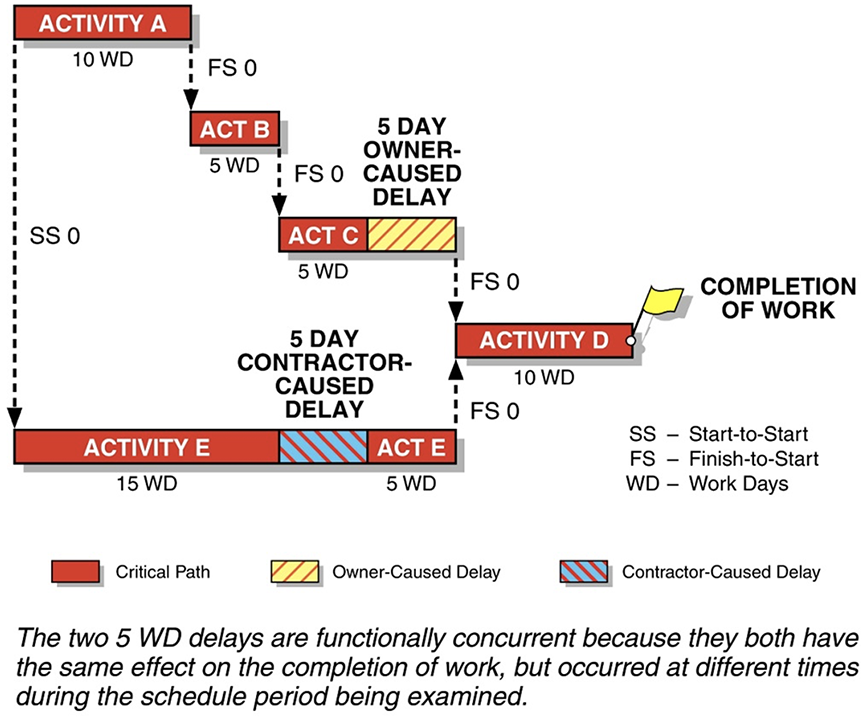
April 24, 2023
Functional Concurrency
This is the second blog post in a two-part series that discusses concurrency. The first post defined concurrent delays and literal concurrency, and this post explores functional concurrency and accounting for concurrent delays.
Functional Concurrency
Concurrent delays rarely line up at exactly the same time. They more likely overlap, partially align, or do not align at all. Moreover, contemporaneous project records may not provide enough information to determine the precise start and finish of concurrent delays. Although concurrent delays may occur at different times within an analysis window, they may have the same critical path impact on overall completion. This type of concurrent delay is called functional concurrency and is illustrated in Figure 1.1
Figure 1: Functional Concurrency

In Figure 1, Activity E has a five-day contractor delay that started and finished before the five-day owner delay on Activity C. Although these delays do not occur at the exact same time, both are functionally concurrent in that they individually delay the start of critical path Activity D by five days.
Accounting for Concurrent Delays
When faced with either literal or functional concurrency, a contractor should offset its own concurrent delays on the critical path against concurrent owner-caused critical path delays. If a contractor does not properly account for its own concurrent delays that impacted the critical path, then recovery of delay-related claims against the owner may be at risk. The following court rulings denied contractor delay claims because contractors did not properly identify, quantify, or apportion their own concurrent delay impacts to the critical path.
- A contractor’s recovery of its delay claim against the owner was rejected because the contractor did not segregate and apportion intertwined owner delays and concurrent contractor delays during construction of multifamily housing units at the Great Lakes Naval Station near Chicago, Illinois. The court found both parties contributed to delay; however, neither party can recover delay damages without clear proof of concurrent delay apportionment.2
- A contractor was not entitled to receive recovery of its delay damages because it did not recognize and properly apportion contractor-caused concurrent delays that should have been offset against owner-caused critical path disruption. The contractor asserted it was delayed by late owner contract award, disruption by government employees, late delivery of owner-furnished materials, and unresolved owner technical work packages. The court did find instances of owner-caused delay but also found instances of unapportioned concurrent contractor delay that the contractor failed to consider.3
- A contractor’s delay claim was disallowed because it failed to separate and apportion its own concurrent delays against owner-caused delays on the critical path. The contractor did not present the court with any schedule analysis that demonstrated how and when the owner caused delay to the project finish. The court opined that unsupported contractor allegations of owner impacts and delays did not satisfy the contractor’s burden of proof.4
- A contractor and owner failed to provide sufficient evidence that properly apportioned concurrent delays impacted the critical path during the construction of the Hoover Dam Visitor Center and parking structure. The contractor claimed delays and impacts from defective owner design drawings, differing site conditions, and change order work. In contrast, the owner assessed liquidated damages against the contractor for late project delivery. The court concluded that neither the contractor’s schedule delay expert nor the owner’s schedule delay expert provided convincing evidence that apportioned concurrent delays.5
- A contractor and its subcontractor were not able to recover delay damages because they did not provide proof of delay apportionment for concurrent delays during the construction of two bridges that spanned the Yadkin River in North Carolina. The court ruled that both the contractor and its subcontractor contributed to critical path delays, but the contractor did not provide any quantitative analysis that would allow the court to apportion critical path delays between contractor and subcontractor.6
1 AACE® International Recommended Practice 29R-03, April 25, 2011, pp. 104–106 of 134.
2 Blinderman Construction Co. v. The United States, 695F.2d 552 (1982).
3 Smith v. United States, 34 Fed. Cl. 313 (1995).
4 Green v. General Services Administration, GSBCA No. 12,621, 96-2 BCA ¶ 28,306 (1996).
5 PCL Construction Services, Inc. v. United States, 53 Fed. Cl. 479 (2002).
6 Flatiron-Lane v. Case Atl. Co., 121 F. Supp. 3d 515 (M.D.N.C. 2015).
ADDITIONAL RESOURCES

Blog
Discover industry insights on construction disputes and claims, project management, risk analysis, and more.
MORE

Articles
Articles by our engineering and construction claims experts cover topics ranging from acceleration to why claims occur.
MORE

Publications
We are committed to sharing industry knowledge through publication of our books and presentations.
MORE
RECOMMENDED READS
Concurrent Delays and Literal Concurrency
This post defines concurrent delays and literal concurrency. This is the first post in a two-part series on concurrency.
READ
Analysis of Concurrent Delay on Construction Claims
This article explores concurrent delay, including the treatment of concurrent delay in various legal jurisdictions, practical guidelines, and more.
READ
Types of Delay
Delays in construction contracts are usually categorized as one of three types. This blog post defines each type, with examples.
READ

